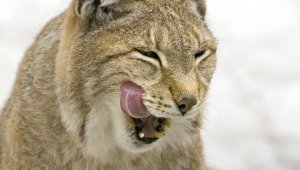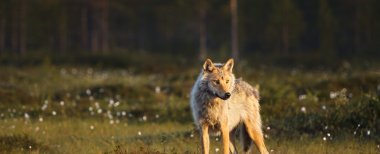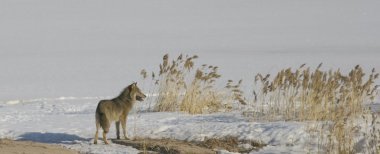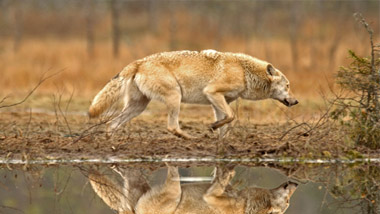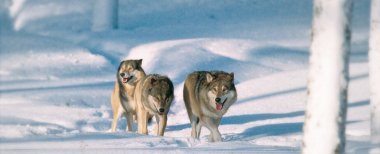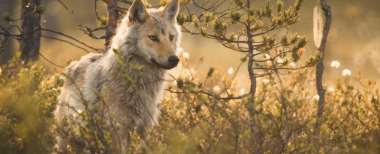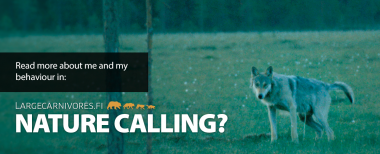Meeting a wolf
The wolf is a sizeable wild animal and large carnivore and you should remain calm and fearless when coming face to face with one. A rabid wolf or a wolf that is put on the defensive may harm a human, but this has not happened in Finland since the late 19th century.
GPS collaring provides extensive and useful information on wolves
Wed Mar 13 14:00:00 2019
The Riistahavainnot.fi shows the geographical location data of collared wolves in 5 x 5 kilometre cells from August through the end of February. The main goal of providing the location data is to prevent attacks by wolves on hunting dogs during the hunting season. The data also helps in the protection of livestock.
The Natural Resources Institute Finland (Luke) has been collaring wolves since 1998. Collaring is an essential tool in wolf research. The collars support population monitoring and its development and provide important information on wolves’ movement, predation and choice of habitat. Information about wolves’ predation behaviour can be further utilised in multi-species population management. The data obtained from collaring is also used in studies about population ecology and attacks on hunting dogs.
GPS collaring requires a great deal of resources, and there are strict requirements for its implementation. In addition to several different permits, successful collaring also requires suitable weather and snow conditions and approval from local operators. With this in mind, the working group emphasised the role of cooperation in the planning and implementation of collaring.
This year, provided that the weather is suitable and the other conditions are fulfilled, the Natural Resources Institute Finland aims to collar wolves in Eastern Finland and in North Ostrobothnia in Western Finland. Following a proposal from the Ministry of Agriculture and Forestry, Parliament allocated EUR 300,000 in additional funding in its 2019 budget for research and monitoring of wolves in Western Finland. The funds will be used for example for collaring efforts in Western Finland.
Communication about wolves plays integral role
The working group also discussed the importance of communication related to wolves. People’s interest in wolves and news about them was emphasised as a positive aspect of wolf-related communication. Communication also faces challenges, however, due to conflicting views on wolves in society. Inaccurate information and rumours, including false claims about transplantation of wolf populations, often find their way into the public discussion on wolves.
The working group emphasised the continued importance of communicating about wolves in a clear and informative manner. Communication about wolves plays an important role in promoting the coexistence of people and wolves. The working group stressed that in order to support this goal, communications are needed about the role of the wolf for the ecosystem and the need for cooperation in conflict resolution.
Communication and information about wolves must reach a very large audience, including people living in wolf territories, various stakeholders and concerned organisations. It is also important to communicate proactively and ensure that information takes root in areas that may become wolf territories in the future. The role of an interactive, bilateral approach to discussions was also emphasised.
The working group stressed the importance of face-to-face communication when dealing with topics related to wolves. They brought up the possibility of using new communication methods, like online town halls or question hours. They also discussed the opportunities presented by social media, as it can reach many different target audiences and provide a platform for discussions and exchange of information about wolves. Social media also comes with its own challenges, however, as polarised discussions do not leave room for different views, and people often resort to inappropriate language.
Read more:
Trapping of wolves for collaring and the required permits, Natural Resources Institute Finland (in Finnish)
Information on wolves and other large carnivores is available on the largecarnivores.fi
Report a sighting
A large carnivore sighting can consist of seeing the animal itself, or spotting the tracks, droppings, carcasses, claw marks or other signs left behind by the carnivore somewhere in the wilds. By reporting your sighting you are taking part in game animal research. Every year tens of thousands of sig...
Damage prevention
Occasionally large carnivores cause damages to domestic animals. Livestock and hunting dogs are the most common targets. However, a significant portion of large carnivore damages may be avoided with the right kind of preventive measures.
Large carnivores in populated areas & road accidents
A large carnivore that causes damage, repeatedly acts in a problematic manner or ventures into a populated area must always be reported to the emergency exchange (tel: 112). The primary aim is to scare the predator away from coming too close to populated areas. The animal is only put down if it is b...
